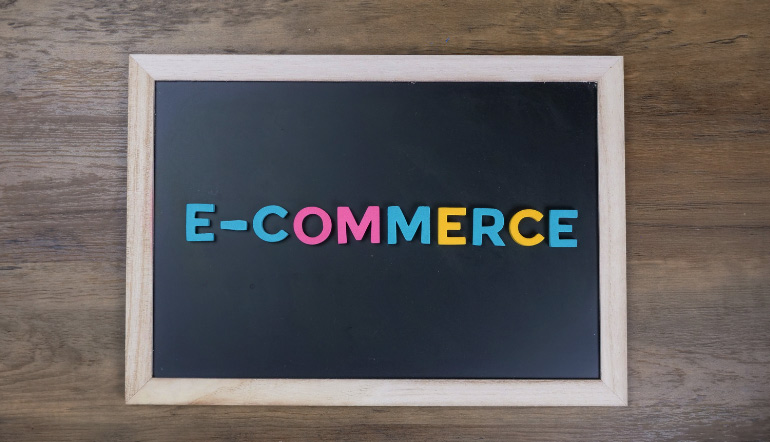
In this lecture you are going to learn about eCommerce – what it is and why it is such a great industry to work in. Also, you will find out what type of products can be sold online and what are the advantages and disadvantages of all of them.
Buying and selling all types of goods and services through an electronic medium is called electronic commerce or eCommerce.
It has become so simple nowadays that anyone can create an online store to display and sell different products and purchasing has never been easier.
If you want to become a successful online employee, it is only logical that you understand what it is, how it works and what types of eCommerce are there.
Here is a screenshot of BeeFriendly Skin Care’s eCommerce store home page to give you the general idea as to how an eCommerce store might appear.

This store sells physical goods to the final customer. It has a home page, shopping cart, contact page, featured products and many more. It even includes a blog and FAQ page to help interact with its customers. These are typical features and pages that you’ll see in most eCommerce stores.
There are many more ways to build an eCommerce store and soon enough, you’ll be a part of that process.
On the other hand, let’s take a look at an example what an eCommerce page IS NOT, so you can see the difference.
This is an example of a blog: A Sonoma Garden that also deals with body care, but also gardening, cooking and different topics. They even have a post about beeswax cosmetics.

You can see that the A Sonoma Garden doesn’t sell anything. It has different blog posts about different topics, but there are no products whatsoever. This means it is NOT an eCommerce website, but a lifestyle blog.
Of course, eCommerce websites can have their blogs, as well, but they are just a part of their eCommerce store and the efforts to be closer to their customers and build trust and their brand. BeeFriendly Skin Care has one, as well:
However, this blog is there only as a support to the main website and not the main attraction and the purpose to itself. Whether it aims at creating a community, building a brand or gaining more traffic to the website – it’s final goal is to gain sales.
In simple words – it is not selling anything – it is not an eCommerce store.
Can you see the major differences between an eCommerce store and non-eCommerce stores?
There is still a lot to learn about eCommerce as this is a very interesting, growing industry and you need to know a lot about it if you want to create a long-term career.
You may remember from your schooling that, whenever you start studying a certain subject, one of the first lessons is about its origin and history. It is needed because it helps you understand the background and the setting of your subject.
The same applies to eCommerce. You’ll understand it better if you learn a little bit more about how it came to be.
Let’s take a look at this brief overview.
Main Events in the History of eCommerce
It’s pretty hard to remember what shopping used to used to be like without eCommerce, so here is a small recap of its history.
At first, the term “eCommerce” stood for the process of exchanging business information and commercial transactions between users via Electronic Data Interchange (EDI) or Electronic Funds Transfer (EFT). All this happened all the way back in 1970s.
A decade later, CompuServe introduced the Electronic Mall which enabled users to purchase from more than 100 online retailers. Take a look at this vintage ad featuring the Electronic Mall.
It is impossible to show a screenshot of how Electronic Mall looked like, or even find it in the Internet Archives, but we can see this very interesting video presentation from those times:
The action that made eCommerce possible, definitely happened in 1991, when the National Science Foundation lifted its ban on commercial Internet use. And after a few years security protocols were developed (HTTP and DSL).
As the Internet itself was growing and improving, eCommerce was also going in the same direction. Many retailers recognized its huge potential regardless of the dot-com collapse in 2000. Here is what happened:
One statistical detail says that by the end of 2001, Business-to-Business (B2B) types of eCommerce had about $700 billion in transactions.
Now, we can’t really talk about eCommerce history and forget about Amazon and eBay. These two were among first Internet companies to allow electronic transactions. Some say that they are actually responsible for the rapid growth of eCommerce.
You can learn more about the history of Amazon from the founder himself: Jeff Bezos tells his amazing story about founding Amazon.
Another amazing success story is told by the eBay’s founder Pierre Omidyar. In his speech he talks about his vision and the creation of the eBay.
Read the article and watch the videos so you can gain a deeper understanding of the topic.
Difference Between the Digital and Physical Goods
When learning about the different products that are available for buying and selling online, people usually think of books, DVDs, electronic devices, etc. But eCommerce offers a lot more!
There are both digital and physical goods available nowadays. There are many different opinions on which one sells better, so here are some of the advantages and disadvantages of both types of products.
But first, let’s introduce them.
Physical Product
A physical product can be anything tangible that you use offline– a book, a ball, a DVD, a car, etc. Buying this type of product resembles going into a brick-and-mortar store and returning home with a product in your bag.
Here are several examples of eCommerce stores that sell different physical products of different sorts:
Example #1
Apparel N Bags makes and sells clothes and offers embroidery services. Their offer is pretty straightforward and they don’t have the need to create a blog or share too much of their vision with the customers.
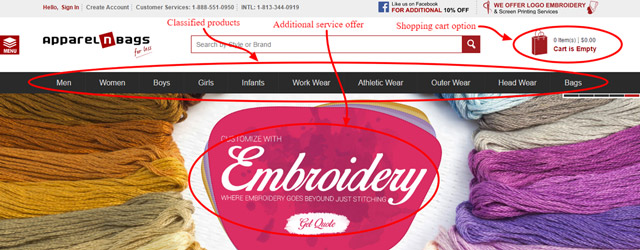
Example #2
Golden Moon Tea offers tea as their main product, but they also have teaware in their product range. Since the product is so specific, they offer much more content and storytelling on their eCommerce website.

Example #3
DVDLand is an example of eCommerce store that doesn’t sell its own products but re-sells merchandise created by other companies. They sell DVDs that are categorised in different ways.
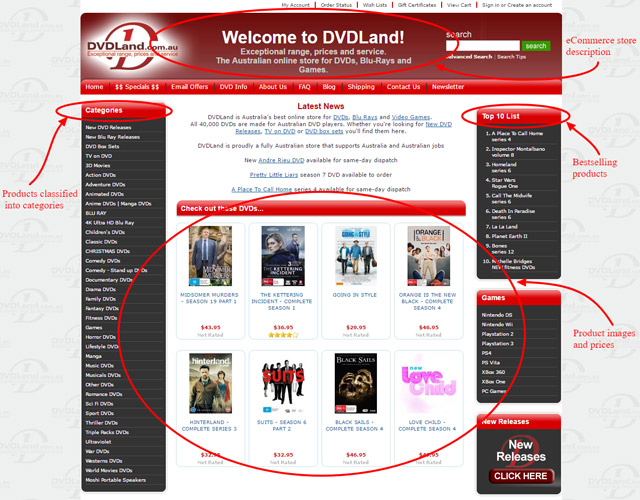
Example #4
The Iron Strength, on the other hand, offers only one DVD set. The main product is the workout DVD, but there is also a book available.
There are three different sets that a customer can purchase. However, the entire website is created only for these products and nothing more, contrary to the example above.

Example #5
Something similar happens at WellnessMama. There is only one product that is to be sold here: the cookbook. The entirety of the rich content on the rest of the website is there with the final goal of selling the cookbook.

These are all different websites, created in a different way and having different concepts. But one thing is the same for all of them – they sell physical goods.
Some advantages of selling physical goods online:
- Ability to offer detailed descriptions of your products
- Possibility to offer lower prices than in a retail store
- Possibility to offer a gallery of images of different products
Disadvantages of selling physical goods online:
- Paying more money for shipping the products that are bigger and heavier
- Extra costs for warehousing
Digital Products
A digital product is not tangible. It exists on your computer, online or in the cloud. It can be an e-book, software, an app or training (lectures and lessons for example). Here are some of the examples of eCommerce stores that sell digital goods.
Example #1
eBooks is an online bookstore that deals only with online books and doesn’t sell hardcopies. The eCommerce website looks exactly like a ‘regular’ bookstore, but without hardcopies.
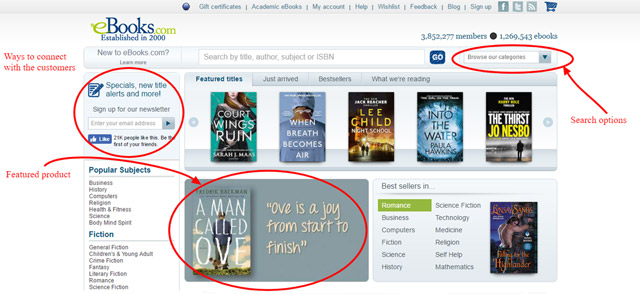
Example #2
CashManager is accounting software that can be used by both accountants and business owners. They offer free trial of their software, but after that, the software needs to be purchased.
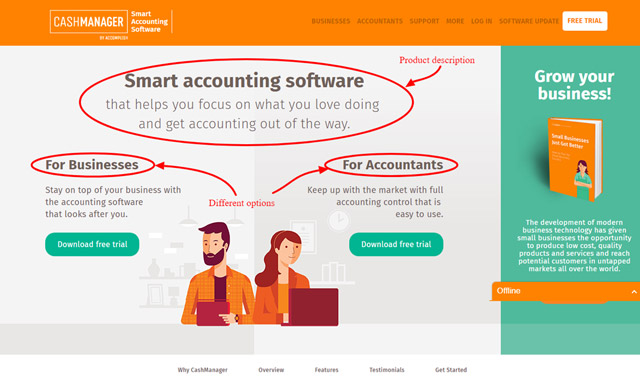
Example #3
Writers.com is an online school of creative writing that offers different courses in creative writing. It is a good example of online training.

When it comes to digital products these are the advantages:
- No shipping
- No extra cost for storage place
- You can never run out of stock
- Easy to deliver since they just need to be downloaded by the customer
- Possibility to reach wider range of customers by using Google Adwords or Facebook Ads
- Lower production costs since in most of the cases you are selling copies of your products
Disadvantages are as follows:
- In case your computer, server or ISP goes down customers cannot get your product until the system is back up
- Extra costs if you want to have a higher bandwidth usage
- In case you are selling an app or software, you have to improve them constantly
Why Is This a Great Industry to Work In? Forefront of Tech
Have you ever thought about the speed of the Internet development? Just think about it for a minute.
Things that sounded like Sci-Fi only a few years ago are now available to anybody with an Internet connection. In some cases, they are even everyday habits.
Just as the Internet is growing and improving fast and constantly, eCommerce business is doing that also. This might be the most important feature of eCommerce business, because it affects you, as well.
When you are in it, it forces you to grow and improve yourself constantly. The best part of it is that, it happens in a way that is interesting, playful and very subtle.
Other, also very important features of eCommerce include:
- The ability to reach a global market without investing too much money.
- There is no geographical limit for an eCommerce business.
- There is a big cost reduction in general.
- It allows suppliers to be closer to their customers
Take a look at this infographic and see just how much the shopping habits of people have changed.
Just a couple of decades ago, nobody would dream of these figures. However, here they are, as we witness eCommerce in its full expansion, shaping the modern economy.
In Summary
According to a research conducted by the Pew Internet & American Life Project tracking surveys, 71% of people use the Internet for shopping.
The situation is quite similar in the EU, where two thirds of people shopped online during 2016. This is really a great industry to work in!
It is growing so fast that some forecasts say that in the next 50 years everything will be sold online. There are many great opportunities you can grasp if you try.
Every sort of online exchange of money and goods is an aspect of eCommerce. Now, the type of goods sold and bought in this way can vary.
As an aspiring online worker, it is important that you start with acquiring basic knowledge about eCommerce that you can build upon.
Firstly, you need to learn the history and the specifics of eCommerce, because you will have a better understanding of the cogs and wheels of the eCommerce company that hires you to work online for them.
Secondly, if you are to work in an industry that grows and evolves as fast as eCommerce does, you need to learn the basics to be able to follow and understand the later changes and trends.
All this knowledge will make you a much more desirable and highly eligible employee among the eCommerce store owners, because it will make you better at your job, whichever position within an eCommerce business you get.
Frequently Asked Question
1. The term “eCommerce” stands for…?
a. Exchange of business e-mails between companies
b. Buying and selling all types of goods and services through an electronic medium
2. What are the examples of digital goods?
a. Softwares, apps, e-books, knowledge
b. Books, wallpapers, lectures
3. Which is a better option for an eCommerce business that doesn’t have warehousing space?
a. Selling physical goods
b. Selling digital goods
